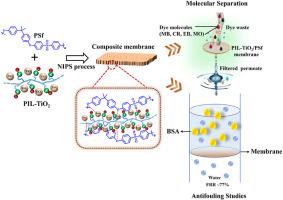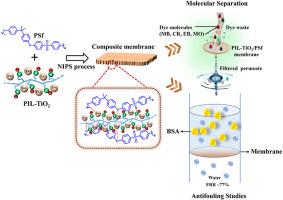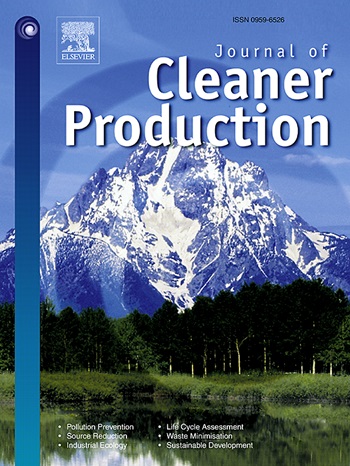Innovation of poly(ionic liquid)-stabilized TiO2 for membrane-based dye waste remediation
IF 9.7
1区 环境科学与生态学
Q1 ENGINEERING, ENVIRONMENTAL
引用次数: 0
Abstract
Organic–inorganic nanohybrids based membrane materials are reported for separation applications. In the present study, poly(ionic liquid)-stabilized TiO2/polysulfone-based mixed matrix membranes are produced using a phase separation technique induced by a nonsolvent. The presence of PIL-stabilized TiO2 nanohybrids and the hydrophilic nature of PIL enhance the overall hydrophilicity of the PSf membrane, reaching an impressive water flux of 158 LMH at an operating pressure of 6 bar. Further, membranes were characterized through, Field emission scanning electron microscopy, X-ray diffraction, Atomic force microscopy, Thermogravimetry, and Zeta potential. The synergistic effect of positively charged PIL and TiO2 nanohybrids enhances the membrane's anionic dye retention capability, achieving retention rates of nearly 90.83% for Methyl Blue, 94.28% for Congo red, 65.89% for Evan's blue, and 30.98% for Methyl orange with respect to dye size. However hydrophilic membrane showed outstanding antifouling property of the M2 membrane achieved ∼77% of flux recovery ratio with minimal of ∼37% total fouling for 1000 ppm of Bovine Serum Albumin as a foulant. Highly efficient nanocomposite membranes exhibit significant potential for dye removal and addressing water contamination issues, making them attractive solutions for sustainable fouling resilient water treatment processes.


聚(离子液体)稳定二氧化钛在基于膜的染料废物修复中的创新应用
据报道,基于有机-无机纳米杂化物的膜材料可用于分离应用。在本研究中,利用非溶剂诱导的相分离技术制备了聚离子液体稳定的二氧化钛/聚砜基混合基质膜。PIL 稳定的 TiO2 纳米杂化物的存在和 PIL 的亲水性增强了 PSf 膜的整体亲水性,在 6 巴的工作压力下,水通量达到了惊人的 158 LMH。此外,还通过场发射扫描电子显微镜、X 射线衍射、原子力显微镜、热重仪和 Zeta 电位对膜进行了表征。带正电荷的 PIL 和 TiO2 纳米杂质的协同作用增强了膜的阴离子染料截留能力,相对于染料尺寸,甲基蓝的截留率接近 90.83%,刚果红的截留率接近 94.28%,伊文蓝的截留率接近 65.89%,甲基橙的截留率接近 30.98%。然而,亲水性膜表现出了卓越的防污性能,在 1000 ppm 的牛血清白蛋白作为污物的情况下,M2 膜的通量回收率达到了 ∼ 77%,总污垢率为 ∼ 37%。高效纳米复合膜在去除染料和解决水污染问题方面表现出巨大潜力,使其成为可持续抗污水处理工艺的有吸引力的解决方案。
本文章由计算机程序翻译,如有差异,请以英文原文为准。
求助全文
约1分钟内获得全文
求助全文
来源期刊

Journal of Cleaner Production
环境科学-工程:环境
CiteScore
20.40
自引率
9.00%
发文量
4720
审稿时长
111 days
期刊介绍:
The Journal of Cleaner Production is an international, transdisciplinary journal that addresses and discusses theoretical and practical Cleaner Production, Environmental, and Sustainability issues. It aims to help societies become more sustainable by focusing on the concept of 'Cleaner Production', which aims at preventing waste production and increasing efficiencies in energy, water, resources, and human capital use. The journal serves as a platform for corporations, governments, education institutions, regions, and societies to engage in discussions and research related to Cleaner Production, environmental, and sustainability practices.
 求助内容:
求助内容: 应助结果提醒方式:
应助结果提醒方式:


